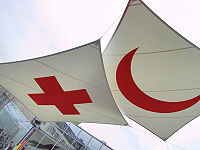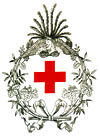| 成立時間 | 1863 |
|---|---|
| 總部 | 瑞士,日內瓦 |
| 服務範圍 | 世界各地 |
| 目標 | Humanitarian |
| 方法 | Aid |
| 網站 | http://www.redcross.int/ |
國際紅十字與紅新月運動在世界各地擁有大約9700萬名志願者,這一國際人道運動致力於保護人的生命和健康,保障人類尊嚴,防止並減輕人類疾苦,不因國籍、種族、宗教信仰、階級和政治觀念而加以任何歧視。
國際紅十字與紅新月運動有三個組成部分:紅十字國際委員會、紅十字會與紅新月會國際聯合會和各國紅十字會與紅新月會。這三個組成部分相對獨立,但擁有共同的基本原則、目標、標誌和章程。
紅十字國際委員會是亨利·杜南於1863年在瑞士日內瓦創立的私人人道機構。該委員會共有25名委員,國際人道法賦予該組織獨特的權力,保護國際和國內武裝衝突受難者的生命和尊嚴。
紅十字會與紅新月會國際聯合會創立於1919年,它負責在運動內部協調186個國家紅十字會和紅新月會的活動。在國際上,聯合會與各國紅會密切合作,負責領導和組織應對大規模緊急事件的救援工作。國際聯合會的秘書處設於瑞士日內瓦。
世界上幾乎每個國家都有自己的國家紅十字會或紅新月會。目前,共有186個國家紅會得到紅十字國際委員會承認並被接納為聯合會正式會員。根據國際人 道法原則和國際紅十字與紅新月運動的章程,每個國家紅會在本國開展工作,依據其具體情況和能力,一些國家紅會可能會承擔一些國際人道法或運動職責並未直接 界定的人道工作。在很多國家,國家紅會通過提供應急醫療服務而與該國衛生系統關係密切。
目錄[隐藏] |
[編輯] 運動的組織結構
全世界約有9700萬人服務於紅十字國際委員會、國際聯合會和各國紅會。運動擁有大約30萬名全職工作人員。
1965年在維也納召開的國際大會通過了運動各組成部分必須遵守的七大基本原則。這些原則於1986年被正式寫入運動章程之中。
- 人道
- 公正
- 中立
- 獨立
- 志願服務
- 統一
- 普遍
紅十字與紅新月國際大會每四年召開一次,是運動的最高管理機構。大會匯聚了來自各國紅會、紅十字國際委員會、聯合會和《日內瓦公約》締約國的代表。 在兩屆大會之間,常設委員會作為最高機構,監督大會決議的實施和遵守情況。此外,常設委員會還協調紅十字國際委員會與聯合會之間的合作。常設委員會由紅十 字國際委員會的兩名代表(包括其主席)以及聯合會的兩名代表(包括其主席)和國際大會選舉的5名代表組成。常設委員會平均每6個月召開一次會議。此外,運 動的代表會議每兩年召開一次,與國際聯合會大會同時召開。代表會議負責規劃和協調運動各成員的聯合行動。
[編輯] 運動內部的各國紅會
[編輯] 對國家紅會的正式承認
全世界幾乎每個國家都有一個國家紅十字會或紅新月會。在各國內部,國家紅會承擔國際人道法所規定的國家救護協會所應承擔的職責。在運動內部,紅十字 國際委員會在法律上負責承認一個救護協會成為正式的國家紅十字會或紅新月會。認可的具體條款在運動章程中有明確規定。章程第四條包含了「承認各國紅會的條 件」。
- 一個國家的紅會如欲得到第五條第2節(2)款的承認,須具備下列條件:
-
- 它應建立在一個獨立的國家領土上,而且改善戰地武裝部隊傷者病者境遇之日內瓦公約已經在該國生效。
- 是該國唯一的全國性的紅十字會或紅新月會,並由一個中央機構領導;在與本運動的其他成員交往時,中央機構是唯一有資格代表該會的。
- 本國合法政府已經依照日內瓦公約和國家立法正式承認它為志願救護團體,擔任政府當局的人道主義工作助手。
- 具有獨立的地位,從而得以按照本運動的基本原則進行活動。
- 採用日內瓦公約及其附加議定書所規定的一個名稱及特殊標誌。
- 組織機構應能便於履行該會章程所確定的任務,並在乎時就做好準備,一旦發生武裝衝突,應能履行公約所規定的法定任務。
- 該會活動須遍及本國領土。
- 在吸收志願工作者和專職工作人員時,不得考慮種族、性別、階級、宗教和政治見解。
- 嚴守本章程,愛護團結本運動各成員的友誼,並與本運動各成員合作。
- 尊重本運動的基本原則,以國際人道主義法指導其活動。
在獲得紅十字國際委員會的承認之後,該國家紅會將被接納為紅十字會與紅新月會國際聯合會的成員。
--日本語
Japanese Red Cross
The Japanese Red Cross Society (日本赤十字社 Nippon Sekijūjisha) is the Japanese affiliate of the International Red Cross.
The Imperial Family of Japan traditionally has supported the society, with Empress as Honorary President and other royal family members as vice-presidents. Its headquarters is located in Tokyo and local chapters are set up in all 47 prefectures. 15,530,000 individual and 220,000 corporate members belong to the society, which operates 92 Red Cross hospitals and 79 blood centers all over the country. The Japanese Red Cross conducts relief activities when major disasters take place. Large earthquakes which frequently occur in Japan (such as the 1923 Great Kanto earthquake and the 1995 Great Hanshin earthquake) are an area of work for the society.
Contents[hide] |
[edit] History

Count Sano Tsunetani founded the Philanthropic Society (博愛社 Hakuaisha), a relief organization for the injured of the Satsuma Rebellion of 1877; a modified version of the Japanese flag was used by the organization until 1887.[1] Its name was changed to the Japanese Red Cross on 2 September 1887 following Japan's admission to the ICRC. Later that year, the Society engaged in its first disaster relief after the eruption of Mount Bandai.
From the beginning, the Japanese royal family, especially Empress Shōken, provided active support for Red Cross activities. During the Russo-Japanese War (1904-1905), the Japanese Red Cross played an outstanding role to rescue many Russian prisoners of war, gaining Japan a considerable amount of good public relations in the western press. After the 1906 San Francisco earthquake, the Japanese Red Cross collected $146,000 for the American relief effort, marking the first overseas operation by the Society.
During World War I, German prisoners of war, captured by the Imperial Japanese Army at their Chinese colony of Tsingtao, were treated fairly well with the help of the Red Cross. In 1934, the Japanese Red Cross society hosted the 15th International Conference of the Red Cross at Tokyo.
During the Second Sino-Japanese War (1937-1945), the Japanese Red Cross played a vital role in assisting Japanese civilians and wounded soldiers. However, as the Imperial Japanese Army tended to ignore the Geneva Convention, government and military restrictions hampered the ability of the Japanese Red Cross to assist the hundreds of thousands of European military and civilians interned in prison camps in the Japanese-occupied areas of Southeast Asia.
After World War II, the Japanese Red Cross was reformed under American advisers. On 14 August 1952, it was given legal status as a special non-profit corporation.
[edit] References
- ^ Hakuai Sha (Japan Philanthropy Corporation), from Flagspot.net
[edit] See also
| Wikimedia Commons has media related to: Japanese Red Cross Society |




沒有留言:
張貼留言